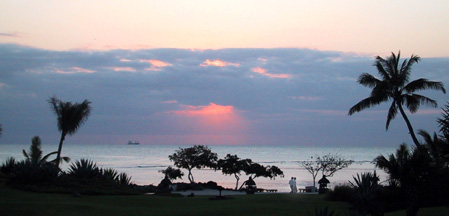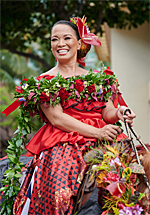Mauritius’ Botanic Gardens
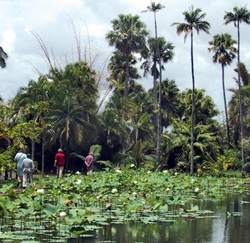 By Ellen Park
By Ellen Park
The Road Trips Gardener
Pamplemousse means grapefruit in English, so it really isn’t a good name for the 62 acres of botanical delights on the island nation of Mauritius known as the Jardins de Pamplemousses. There probably are grapefruit trees, but it’s the sheer diversity of the botanic specimens that makes it a must-see for Road Trips Gardeners.
The gardens were first laid out in the 1700s by François Mahé de la Bourdonnais, the French governor of Mauritius who build his house on the site. Later, Pierre Poivre (a French noble determined to grow spices on the island) bought the land. In a quest to figure out what grew best, he collected specimens for the gardens from around the world: laurel from the Caribbean, camphor from China, breadroot from the Philippines and litchi from Indochina.
After the felicitously-named Poivre (which means “pepper” in French) returned to France, Nicolas Céré, a botanist, continued the gardens’ development. These days, Les Jardins de Pamplemousses are an outstanding collection of exotic plants and trees — including a Talipot Palm that flowers just once every 60 years (but not while I was there).
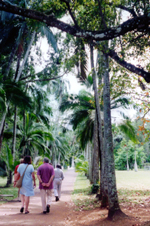 I picked up an inexpensive self-guided tour booklet (in English) when I entered the Sir Seewoosagur Ramgoolam Botanical Garden (its official name since 1988), and wandered from spectacular plant to fantastic tree. Don’t miss the banyans, water lilies or lotus.
I picked up an inexpensive self-guided tour booklet (in English) when I entered the Sir Seewoosagur Ramgoolam Botanical Garden (its official name since 1988), and wandered from spectacular plant to fantastic tree. Don’t miss the banyans, water lilies or lotus.
Mauritius, a small island in the Indian Ocean has such a checkered past that its ethnic mix is like nowhere else in the world. Once known as Île de France, Mauritius remains so Francophile that the preferred language of everyday conversation is French.
However, the island, which gained independence in 1968, is part of the British Commonwealth. They grow tea here, and imbibing the brew is a legacy of English occupation. To this day, it remains unique: have you been somewhere that you can get a really good croissant – and a really good cup of tea?
It also has been a Dutch colony and, before that, a stopover for Arab and Portuguese sailors. Plus, there are the descendants of African slaves and indentured servants from India. All combine with the handfuls of European expats to create a nation of 1.2 million that’s unusually exotic. I was continually startled when dark-eyed women in brightly colored saris would greet me with a musical bonjour!
The island does have one big claim to fame. Remember the dodo bird? This is where it was driven into extinction – not so much by the European settlers, but by the housecats they brought with them (what carnivore could resist pouncing on a bird that didn’t fly away?).
Although centuries of sailors (and pirates) had made note of the island, it seems there was no indigenous human population at the time of the Dutch arrival in 1598. True royalists, they named it for the Prince of Orange, their own Maurice of Nassau. The Dutch harvested ebony wood, but lost interest in the island in 1710. Five years later, the French arrived.
The island was under the supervision of the Compagnie des Indes from 1715 to 1764. While nearby Île de Réunion flourished as a coffee plantation, development on Île de France languished until the arrival of François Mahé de la Bourdonnais as governor in 1735. He laid out the town of Port Louis and created the island’s first sugar estates.
The French ceded the island to England in 1810, and sugar production continued to increase. By 1858, there were 259 factories in operation.
The French had imported slaves from East Africa and Madagascar to work the sugar plantations they established on Mauritius, but the British outlawed slavery in the 1830s.
They imported their labor in the form of indentured servants from India until 1909.
When Mauritius gained independence in 1968, it remained with the British Commonwealth. Although English is the official language, most everyday conversation is in French (albeit with a Creole lilt).
One terrific reason to visit Mauritius is the opportunity to step out of the ordinary. Instead of deadlines and traffic, there’s leisure and tranquility. The warm breezes carry the scent of flowers. Tropical birds flit among the palms, and frogs fill the twilight with their deep-throated croaks.
I enjoyed an afternoon at Pamplemousses gardens, had lunch barbecued by my captain on a boat trip to a picturesque cove, drove a bit along the Tea Route, visited a former sugar plantation and took an underwater trip on a mini submarine.
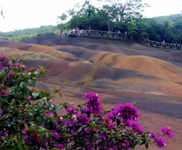 The island is volcanic, so the topography is varied. There are steep jagged peaks inland with waterfalls plummeting off cliffs into deep rocky valleys. At Black River Gorge National Park, the resident monkeys begged treats from visitors. I marveled at the seven-colored earth of Chamarel – if I could only remember what I learned in my college geology classes, I’d know what caused the colors of the rainbow-hued volcanic dunes.
The island is volcanic, so the topography is varied. There are steep jagged peaks inland with waterfalls plummeting off cliffs into deep rocky valleys. At Black River Gorge National Park, the resident monkeys begged treats from visitors. I marveled at the seven-colored earth of Chamarel – if I could only remember what I learned in my college geology classes, I’d know what caused the colors of the rainbow-hued volcanic dunes.
At Bois Chéri, a tea plantation and factory that welcomes visitors, I watched the processing and learned that the locals definitely prefer theirs scented with vanilla, so that’s the variety I bought to bring back home.
L’Aventure du Sucre (once a massive sugar factory, has been turned into a terrific museum. Displays show not only how the cane is grown, processed and turned into sugar and rum, but the entire history of Mauritius is outlined. The visit ends (of course) in the gift shop with tastings of sugar with varying degrees of molasses and, finally, rum. Yum!
A ride on the Blue Safari submarine took me not as far as 2000 leagues under the sea, but at 35 meters, we were eyeball-to-eyeball with tropical fish I’d only seen in tanks. In a leisurely journey of almost an hour, we circled a shipwreck and surveyed the diversity of corals before surfacing again.
The biggest town on the island is Port Louis, and I spent a wonderful afternoon wandering the local market (when you have a population that’s Indian, Chinese, African, Creole and European, the spices, fruits and vegetables are many and varied). The dried fish looked positively prehistoric, and the herbal medicine stands were a wonder to behold.
The Central Market in Port Louis is open daily from dawn to dusk between Farquhar and Queen streets. When you’re tired of reality, you can go across the street to Caudan Waterfront, a shopping center. A hint: all that “brand name” merchandise isn’t what it seems (I could go into a long discussion about trademark laws on the island – but I’ll spare you. Suffice it to say, “Ralph Lauren” isn’t).
The sunsets over the Indian Ocean each evening were symphonies of pastels. My only disappointment was the night sky. There was a full moon while I was on Mauritius, and its light was bright enough to keep me from spotting the Southern Cross or any other unfamiliar constellation of stars.
Then, there’s nothing like watching the expressions on people’s faces when you say you’ve been to Mauritius. Umm, where’s that?
